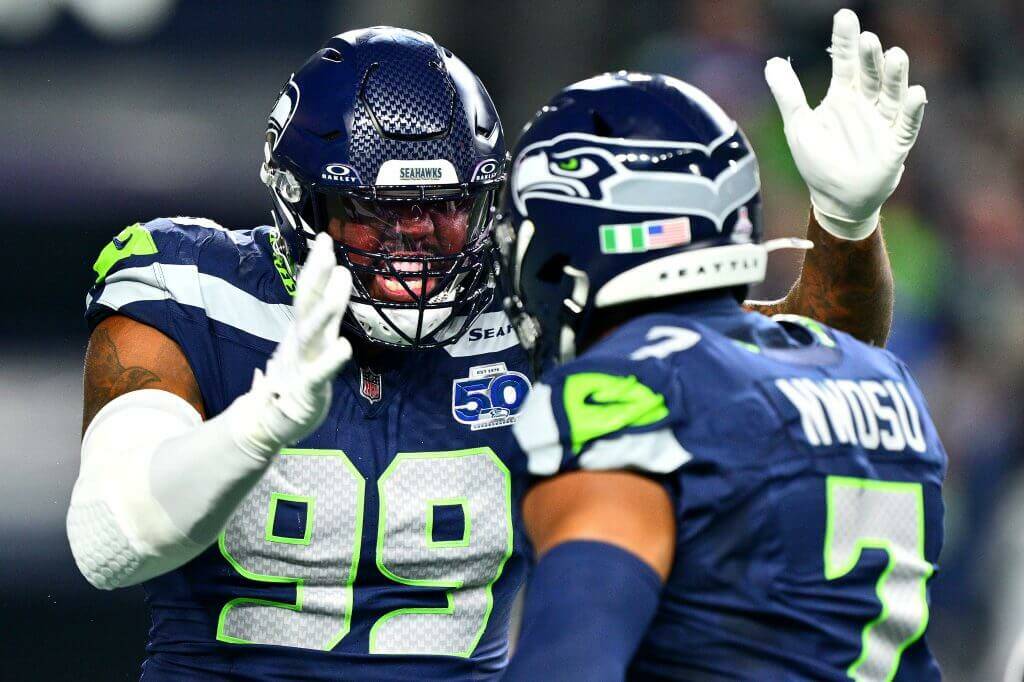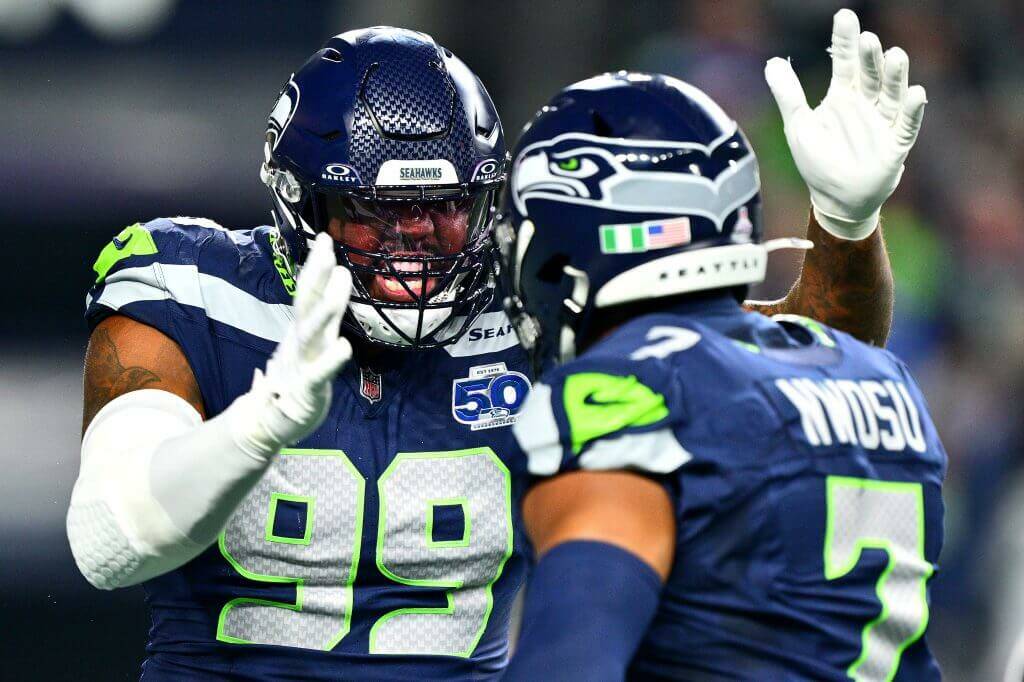RENTON — Seattle Seahawks coach Mike Macdonald has a good problem on his hands.
His defense is one of the best in the league, ranking sixth in points per game (19.4), fourth in points per drive (1.60) and sixth in EPA per play (all stats provided by TruMedia). As the sample size grows, evidence is building to suggest the Week 5 loss to the Tampa Bay Buccaneers — in which Seattle gave up 38 points and had just one quarterback hit — was an outlier performance. The other six games have been more indicative of who the Seahawks are and the style of play they are likely to deploy on any given Sunday.
Coming out of the Week 8 bye, Seattle might have its defense at full strength for the first time since the first series of the season opener.
Pro Bowl cornerback Devon Witherspoon has missed five games and hasn’t played since Week 4 in Arizona because of a knee contusion. Pro Bowl safety Julian Love (hamstring) has missed three games and also hasn’t played since Week 4. When Love and Witherspoon were available in the win over the Cardinals, rookie defensive back Nick Emmanwori wasn’t. Outside linebacker Derick Hall has missed the past two games with an oblique injury.
Macdonald expects all three defenders to return in Week 9 when the Seahawks (5-2) travel to face the Washington Commanders (3-4). While those starters have missed time, Seattle’s defense has received notable contributions from Emmanwori, Derion Kendrick and Ty Okada. Josh Jobe began the year as the No. 3 cornerback but has been the team’s most consistent defensive back.
Among the tasks for Macdonald and his staff coming out of the break will be to find a way to make all these talented puzzle pieces fit.
“That’s something we’ve got to figure out,” Macdonald said Tuesday, “how to play our guys.”
This time last year, Seattle was shuffling its lineup for the opposite reason. The result was finding out that Jobe and safety Coby Bryant were worthy of full-time starting jobs and that linebackers Tyrice Knight and Ernest Jones IV — acquired by trade one year ago this week — were better equipped to man the middle of the defense than Tyrel Dodson and Jerome Baker.
But last year was more about moving pieces around to fix a bad defense. The current unit is very good. Macdonald just needs to maintain it.
“Ultimately, we want to be the best defense in the league, and when we say that and put that in the air, we’ve got to work for it every day,” Jones said Monday night. “I believe we do a great job of that on defense, and we’re going to continue to do that.”
Seattle’s 27-19 win over the Houston Texans on Monday night at Lumen Field showcased so much of what has allowed the defense to thrive through the first seven weeks. It starts with the run defense, which held Houston running backs Nick Chubb and Woody Marks to 31 yards on 15 attempts with just one first down.
Running backs have gained just 402 yards against Seattle, the lowest output among teams that have played seven games (the Packers have given up only 399 yards in six games). On running back carries, the Seahawks rank No. 1 in EPA and seventh in success rate. They’re stuffing runs at a high rate and have surrendered just two touchdowns to a running back (both by Tampa Bay’s Rachaad White); only the Los Angeles Rams have a lower total (zero).
Seattle has one of the best defensive fronts in the league, anchored by defensive tackles Leonard Williams, Byron Murphy II and Jarran Reed, along with outside linebacker DeMarcus Lawrence, whose physicality pops off screen nearly every week.
“We jokingly call (Lawrence) the ‘crash out,’ because of how he throws his body around out there,” Williams said Monday. “You respect guys like that. He’s (in) Year 12, I believe now, (and) he’s still putting his body on the line every play. He plays really hard on the run.”
A pair of 13-yard runs by San Francisco’s Christian McCaffrey and Pittsburgh’s Kenneth Gainwell are the longest carries Seattle has allowed this season (that’s tied with the Rams for No. 1 in the league). Explosive runs have been hard to come by, which is a testament to the players at the second and third levels such as Jones, Bryant, Jobe and, more recently, Emmanwori.
“Those guys are making alley-type tackles, third-level tackles to limit explosives,” Macdonald said of his back-seven defenders. “We’ve missed some of those tackles throughout the year, and guys have made a concentrated effort improving their technique and getting guys on the ground when they need to, making fast reads, getting in the alley. Taking proper leverage on the ball is huge. It’s just a function of reps and how you practice.”
Seattle’s opponents are averaging just 5.8 net yards per pass attempt (fifth lowest), which takes sack yardage into account and paints a contextualized picture of how hard Macdonald is making it on quarterbacks. The Seahawks are third in sacks (23) and have above-average sack and pressure rates. Twelve players have at least a half-sack, including five defensive backs, yet Seattle has the third-lowest blitz rate.
Seattle also ranks in the top five in interceptions (eight) and passes defensed (38). Macdonald’s scheme consistently puts defenders in position to make plays on the ball, either when the quarterback is still holding it or after he lets it fly. Four players had multiple passes defensed on Monday night, led by inside linebacker Drake Thomas with three. Emmanwori, Jobe and Riq Woolen had two apiece.
“To have Riq and Jobe (and) E-Man stand out the way they did outside with guys down, that means everything,” said Jones, who leads the team with three interceptions after picking off Texans quarterback C.J. Stroud on Monday. “Those guys, they’ve been working their butts off. To see them win these battles, that’s a big boost for us going into the bye week and going into the end of the season.”
There’s a chance Seattle will have more games like Monday night, which required the defense to hold down the fort while the offense kept turning the ball over. The chemistry between quarterback Sam Darnold and wide receiver Jaxon Smith-Njigba is making the offense very difficult to stop. But opponents have found some success slowing Seattle’s offense by limiting explosive runs and third-down conversions. Macdonald and offensive coordinator Klint Kubiak have some kinks to work out on that side of the ball during the bye week.
In the meantime, the Seahawks can feel confident in their defense’s ability to carry the load. The expectation going into the season was dominance. They’ve delivered thus far, and all signs point to an even better second half of the season as the unit gets closer to full strength.
Talk to us
> Give us your news tips.
> Send us a letter to the editor.
> More Herald contact information.


























